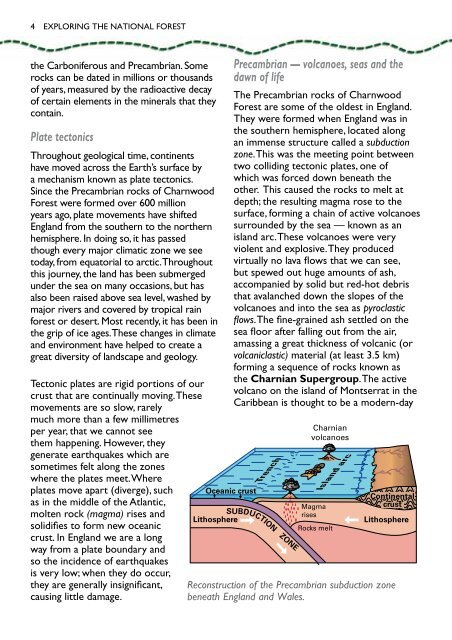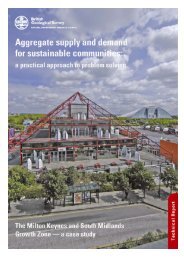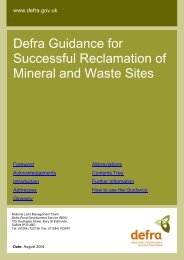Book - Sustainable Aggregates
Book - Sustainable Aggregates
Book - Sustainable Aggregates
You also want an ePaper? Increase the reach of your titles
YUMPU automatically turns print PDFs into web optimized ePapers that Google loves.
4 Exploring The national forest<br />
the Carboniferous and Precambrian. Some<br />
rocks can be dated in millions or thousands<br />
of years, measured by the radioactive decay<br />
of certain elements in the minerals that they<br />
contain.<br />
Plate tectonics<br />
Throughout geological time, continents<br />
have moved across the Earth’s surface by<br />
a mechanism known as plate tectonics.<br />
Since the Precambrian rocks of Charnwood<br />
Forest were formed over 600 million<br />
years ago, plate movements have shifted<br />
England from the southern to the northern<br />
hemisphere. In doing so, it has passed<br />
though every major climatic zone we see<br />
today, from equatorial to arctic. Throughout<br />
this journey, the land has been submerged<br />
under the sea on many occasions, but has<br />
also been raised above sea level, washed by<br />
major rivers and covered by tropical rain<br />
forest or desert. Most recently, it has been in<br />
the grip of ice ages. These changes in climate<br />
and environment have helped to create a<br />
great diversity of landscape and geology.<br />
Tectonic plates are rigid portions of our<br />
crust that are continually moving. These<br />
movements are so slow, rarely<br />
much more than a few millimetres<br />
per year, that we cannot see<br />
them happening. However, they<br />
generate earthquakes which are<br />
sometimes felt along the zones<br />
where the plates meet. Where<br />
plates move apart (diverge), such<br />
as in the middle of the Atlantic,<br />
molten rock (magma) rises and<br />
solidifies to form new oceanic<br />
crust. In England we are a long<br />
way from a plate boundary and<br />
so the incidence of earthquakes<br />
is very low; when they do occur,<br />
they are generally insignificant,<br />
causing little damage.<br />
Oceanic crust<br />
Lithosphere<br />
Precambrian — volcanoes, seas and the<br />
dawn of life<br />
The Precambrian rocks of Charnwood<br />
Forest are some of the oldest in England.<br />
They were formed when England was in<br />
the southern hemisphere, located along<br />
an immense structure called a subduction<br />
zone. This was the meeting point between<br />
two colliding tectonic plates, one of<br />
which was forced down beneath the<br />
other. This caused the rocks to melt at<br />
depth; the resulting magma rose to the<br />
surface, forming a chain of active volcanoes<br />
surrounded by the sea — known as an<br />
island arc. These volcanoes were very<br />
violent and explosive. They produced<br />
virtually no lava flows that we can see,<br />
but spewed out huge amounts of ash,<br />
accompanied by solid but red-hot debris<br />
that avalanched down the slopes of the<br />
volcanoes and into the sea as pyroclastic<br />
flows. The fine-grained ash settled on the<br />
sea floor after falling out from the air,<br />
amassing a great thickness of volcanic (or<br />
volcaniclastic) material (at least 3.5 km)<br />
forming a sequence of rocks known as<br />
the Charnian Supergroup. The active<br />
volcano on the island of Montserrat in the<br />
Caribbean is thought to be a modern-day<br />
Trench<br />
SUBDUCTION ZONE<br />
Charnian<br />
volcanoes<br />
Magma<br />
rises<br />
Rocks melt<br />
Island arc<br />
Continental<br />
crust<br />
Lithosphere<br />
Reconstruction of the Precambrian subduction zone<br />
beneath England and Wales.

















